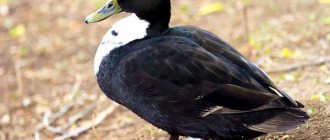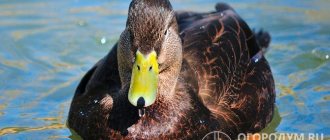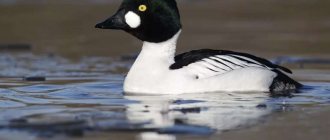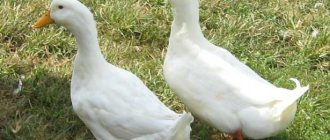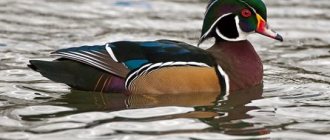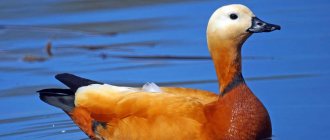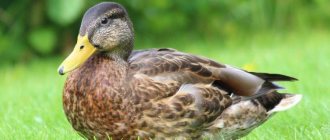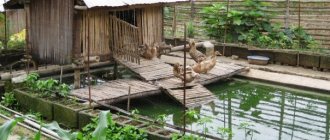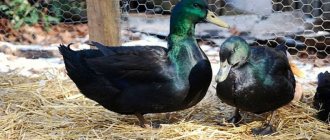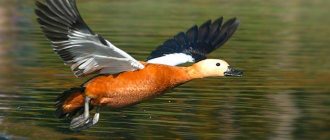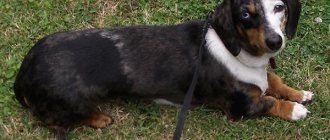Who said a duck can't be a good mother?
What is it that all the inhabitants of the animal world are unable to feel? Believe me, this opinion is not only wrong, but is a complete contradiction to the behavior of small ducks - teal. Do you want to know the truth? Then let's get acquainted with the beautiful inhabitant of rivers and lakes. The teal is a small creature that is more than half the size of a mallard. Representatives of this breed can be found in almost every corner of Russia. A waterfowl of tiny size (the weight of an adult drake is almost half a kilogram, and the female is half that size) has a specific whistle. You can use it to identify the bird.
Appearance
Teal is a small wild duck. It has a short neck, pointed wings up to 38 cm and a wingspan of 55-64 cm. The bird differs from other types of ducks in its narrow wings, which allow it to rise almost vertically.
Both individuals of chirik have some external differences. The male has a brown-chestnut head, with a green-blue stripe running from the key to the neck through the eye. His chest is pinkish with dark spots, his undertail is black and yellow. The main color of the chirp is ash-gray. The beak is black-brown, the paws are gray-brown. Duck rainbow nut.
Male teal
The color of the drake is not always the same. In summer and autumn the color becomes brownish-gray. To distinguish him from the female during this period, you need to take a closer look at the beak (it is always black) and the unique mirror (inside - green with a lilac-green sheen, outside - velvety black, behind - white edging, in front - brown stripes).
Summer and autumn
Winter and spring
The female does not change color at different times of the year. It is purple with light brown accents. The head is brown-gray, and lighter underneath. Near the cheeks and throat the color is almost white. The female's speculum is almost identical to the male's, but has a white border and is itself narrower.
Female
Breed differences
The teal weighs about 0.5 kg. The main feature of the teal is the structure of its wings. They are narrow, with pointed ends, so the bird can fly almost vertically. This feature allows the teal to land even in the most inaccessible places. Teal are not at all whimsical regarding their place of residence, so their settlements can be found throughout Russia, except for the northern cold zones. Most often, birds settle near small forest lakes or swamps with standing water.
There are several varieties of teal:
- brown teal;
- spotted teal;
- teal;
- blue-winged teal;
- Pune Teal;
- multi-colored teal;
- teal duck.
The characteristic name was given to the birds for their voice. During the mating season, the male invites females by throwing back his head and emitting a whistle or bubbling sound. The voice is used only during the mating season to attract a female with whom common offspring will be created. Teals are divided into small groups. Nesting sites are built near water bodies. They dig a hole in the ground and line the bottom with leaves, grass, and twigs. The bird places its feather around the nesting circle.
Differences between males and females
Male and female teal ducks have some differences:
- Weight. The female weighs 200-400 grams, and the male 250-450 grams.
- Size. The body length of the female is 29-34 cm, and the male is 32-39 cm.
- Appearance. The female does not change color during the year, but the drake changes during the mating season.
- Mirror. Their color is almost the same, but the female’s mirror is narrower and edged with white stripes in front and behind. In addition, the mirror of drakes is brighter than females.
- Voice. The male’s cry is a clear whistle, performed at a high note, and the female’s is a weak, nasal, fading quacking “ha-ga-ga” or “cry-cry.”
- Shedding. The male duck molts after mating in June-July and can be distinguished from other duck species only by its black beak and mirror stripe on the wings. The female molt occurs in late summer or early autumn.
Interesting facts about the bird
The common teal cannot be considered an ordinary bird. The whistle has several interesting features:
- the whistler has the title of one of the smallest ducks;
- cubs stop diving as they grow older;
- drakes change plumage only during the period of courtship with a female; the rest of the time, ducks have the same colors;
- silent flight;
- Most females build a nest and lay eggs on their own. Males at this time already live separately, although not far away;
- The pairs winter separately. Drakes can remain in their familiar place when the duck necessarily flies south;
- This group of teals is rightfully considered by ornithologists to be the calmest and most frivolous;
- In response to poor camouflage, nature rewarded these ducks with extreme dexterity.
The unpretentious way of life and appearance of this bird allows a person to also be careless about its life. Fortunately, not all people are so careless in showing responsibility for the environment.
Do you have any questions about Chirki Whistles or something to add? Then write to us about it in the comments, this will make the material more useful, complete and accurate.
Types of teal
The types of teal include:
White-eyed duck – differs in plumage and eye color;
White-eyed Pochard
Teal kloktun - differs in plumage color;
Teal kloktun
Marbled or narrow-nosed teal - differs in plumage color;
Marbled or narrow-nosed teal
White-headed duck - differs in the shape and color of the beak, the location of the tail;
White-headed Duck
Greater merganser - differs in plumage and beak shape;
Great merganser
Teal-gadder - different in voice and color;
Teal
Shoveler - distinguished by an elongated beak and plumage color;
Shoveler
Tufted duck – distinguished by its plumage and gregarious lifestyle;
Tufted duck
Gray duck - differs only in the color of the plumage;
Gray duck
Wigeon - different in voice;
Wigeon
Long-tailed duck - differs in tail shape and color;
Sailor
Mallard or common mallard - different in voice and color;
Mallard
Red-nosed Pochard – differs in the color of its feathers and beak;
Red-nosed Pochard
The red-headed duck differs only in the color of its plumage;
Red-headed Pochard
Common goldeneye - differs in plumage and head shape.
Common goldeneye
What does teal look like?
The duck differs from other representatives of waterfowl in its small size. The teal is smaller than the pigeon. Its body length is up to 30 cm, weight 350 g. Females are smaller than males. The bird is commercial. Hunters note the good taste of teal meat. There are few feathers obtained from small ducks, but they are valued for their excellent thermal insulation properties:
- The main color of teals is brown or gray, but nature has painted the drakes in bright shades. Males are visible from afar. The feathers on their heads are bright red. The eyes are framed in emerald circles, which are delimited by a narrow white stripe. On the chest, among the gray or brown plumage, pinkish shades stand out. The plumage on the tail is black, at the base of the tail the feathers are bright yellow. The mirror is formed by dark green flight feathers;
- After the end of the mating season, the drakes molt. Until autumn they remain gray-speckled or brown. In the fall they undergo a second moult. The plumage begins to play with its original colors again;
- individuals always keep in pairs, but before migrating to another body of water or fields, before migration they gather in flocks;
- The bird is nocturnal. A small duck is defenseless against birds of prey, animals and humans. In search of food, flocks can fly from their native reservoir to meadows with lush vegetation or to fields with cereal crops. They fly late in the evening or at night. Before dawn they return to their native creek;
- The teal duck feeds on algae, small fish, and insect larvae. Birds dive for prey, submerging half in the water;
- flocks often go ashore and graze in the meadows. They prefer dense vegetation. In tall grass, a small duck becomes invisible.
More on the topic: How to keep a Bashkir duck?
Birds have many enemies on the pond. They are attacked by nutria, large fish. Teal tries to escape from them. Nature has endowed birds with a special wing structure. Ducks take off from a place, without running through the water, without additional flapping of their wings. The takeoff is sharp and rapid.
Ornithologists count 20 species of teal. They differ in plumage and habitat. On the territory of Russia there are only 2 species of ducks: teal and gadder:
- The whistler is distinguished by its bright breeding plumage. It is especially noticeable on the head. The drake's voice is characterized by high notes, similar to a thin whistle. The male whistles to call the female and warns other individuals of danger. Females do not whistle. They make nasal sounds;
- The rattlefish produces a loud, rolling crack. The plumage of the drake is more modest than that of the whistler. The cover is uniformly brown. The mirror is formed by white feathers. During the mating season, the plumage hardly changes, only a wide, white stripe runs across the eye;
- The green-winged teal is native to North America. Its main plumage is gray. But on the back and wings there are green shades. The color of the head is bright. Red and green colors predominate;
- yellow-billed - found in South America. Individuals have a bright yellow beak. The plumage is brown. Drakes are not much different from females;
- blue-winged - lives in the northern regions of Canada, found in Alaska. Males are distinguished by dark blue plumage on the head, back and wings. The beak and metatarsals are dark. Females have gray plumage. Individuals are considered the largest among teals. Their body length is 40 cm, weight 450 g;
- The Auckland teal duck is common in the Auckland archipelago. It is located in the Pacific Ocean, south of New Zealand. Externally, the bird looks like a small mallard duck. The drake has the same breeding plumage: a brown outline, a dark green tint on the head, blue or green flight feathers.
The Sunda teal lives in Indonesia, and the Madagascar teal lives on the island of Madagascar. In Africa, the main population of ducks in this group is the Cape variety: large individuals, body length up to 50 cm, weight more than 700 g. The Campbell teal is unique. He cannot fly and lives on land. It hides in the dense vegetation of the steppes, in tree hollows, and in burrows. He lives in New Zealand.
Where do the teal and garnet live?
For living, ducks prefer aquatic areas - the banks of reservoirs, swamps. For nests they choose small river thickets, plants overgrown with reeds, and grassy places. River ducks are afraid of being in open spaces. In the spring-autumn period they live in the northern regions of Eurasia and Japan, on islands with temperate and harsh climates. In winter, united, they go to northwest Africa, the Middle East, south Asia, Iceland, and Japan.
Habitats
Teal have settled throughout the territory of our country and the CIS countries, except for the northern regions. The main condition for the construction of a dwelling is the presence of small shallow reservoirs with standing water, densely overgrown with vegetation. Such places are full of different types of food: insects, plants, shellfish. They are located in thickets near the shore. Teal homes are often found far from lakes, since during the summer the water level in the lake decreases, and as a result, their habitats move away from the water.
From September to November, a long migration for wintering begins. Males and females often spend the winter separately. Ducks head to southern latitudes, and males to northern latitudes.
Nutrition
In the spring and summer, ducks feed on animal feed - aquatic life, beetles, larvae, snails. To do this, they dip their beak into the water and strain out the food. In the fall, they look for vegetation, plant seeds, grass, and grains. To search for plant food, ducks clumsily come ashore, waddle from place to place, and rummage through the grass with their beaks in search of food. Meal times are preferably at night, early morning, afternoon.
Characteristic
The description of some subspecies needs to be considered in more detail. The female teal cod is gray in color with a long beak. The drake has an ash-gray wing color on the outside. During mating games, the head plumage becomes reddish-brown in color, and a white stripe stretches from the eye to the back of the head. It is very easy to distinguish the sex of birds: males make a characteristic sound in their voice, reminiscent of “cre-crerr”, the girl makes a high-pitched “quack” and her plumage is darker in color.
The whistler is the most compact representative of the species. The female is distinguished by its gray color, dark shoulders and a spot on the head. The male teal has a white stripe on its shoulder, and the space between its tail and belly is yellow. Flocks of ducks are capable of making quick, maneuverable, synchronized turns.
The spotted or marbled representative is found in the Caspian region and the Volga delta. This is one of the endangered species.
Adult ducks weigh 400-600 g and have a trusting character. They spend a lot of time in bodies of water, dive and move through the water very well. The usual habitat for these birds is small bodies of water with dense vegetation. Their drainage by humans reduces the population of wild ducks.
Birds of the continents, the kloktun teal is an “aristocratic” representative of the genus. They are considered the most desirable prey among hunters, because they are quite rare on Russian lands. In most cases, they can be found on Sakhalin Island and Central Asia. The teal head is decorated with golden-green abstractions.
Migration
Migration of dabbling ducks begins in August. At this time, their fat reserves are actively increasing, and their bodies are physiologically restructuring, preparing for the flight. The flight itself takes place in October-December. The formed flock of ducks winters in Western Europe and returns to the nesting site in the same composition. Before returning to its habitat, the teal also accumulates fat reserves, increasing its mass for a long flight. They return to the nesting site from wintering in early March, and to the northern regions in April-May.
Since dabbling ducks are preferably social, they live in flocks. A flock of ducks can reach up to 1,500 individuals.
flock of ducks
Reproduction and lifespan
Ducks reach sexual maturity at one year of age. Teal begin to select partners for themselves even during the migration; some birds begin mating only at the nesting site. They arrive at the end of March or mid-April, as soon as areas of open water appear.
The courtship process is loud and noisy. The male circles around the female, shows off his bright outfit, flaps his wings and makes loud sounds, can lower his beak into the water, and then sharply lift his head to create a fountain of splashes.
Expert opinion
Zarechny Maxim Valerievich
Agronomist with 12 years of experience. Our best country expert.
Ask a Question
The female makes her partner understand her interest by quacking. Many drakes take to the air, circling over the lake and becoming targets for hunters.
Birds build nests with a diameter of 15-18 centimeters 150 meters from the water in sedge bushes, windbreaks, and willow bushes. They dig holes and line them with feathers and down. The female lays 8-15 eggs and incubates them for 21-24 days. Immediately after the last egg has been laid, the drakes create male flocks and move to areas of seasonal feather replacement.
Ducklings hatch in June-July, immediately after birth they are able to independently obtain food for themselves, are covered with a dense layer of fluff, and actively swim, diving under water. The duck flies when it is one month old. As their offspring grow older, teals change their feathers and wander in flocks to their usual places of food, waiting for the autumn migration to the south. Teal are considered the longest-lived of all duck species. They live to be 18-19 years old, and sometimes up to 21 years old.
See also
Instructions for use and composition of Enroflon for ducklings, dosage and analoguesRead
Reproduction
Although teal is a migratory bird and spends the winter in the south, its habitat is chosen near fresh water bodies, swamps, river mouths, marshy meadows, and along sea coasts. In the second half of spring, ducks build a nest, camouflaging it as much as possible (using dry grass and small branches).
A pair of teals is formed during wintering. They fly together in search of a nesting site and line the nest. The drake, unlike other species of ducks, does not defend its nest, but is aggressive towards rivals towards its female. During mating games, to attract the attention of the female, the drake makes a sharp sound reminiscent of a whistle. To do this, he plunges his head into the water, sharply raises it up and emits a “chir-chir” whistle.
Duck and offspring
The female (mature at 1 year) lays 8 to 12 oblong, dark beige eggs. The shell of the egg is matte, it weighs 26 grams, diameter is 31-35 mm. The female incubates them for 21-23 days. The eggs hatch simultaneously over several hours. This is achieved by not having a hen. The female sits on the eggs only after they are completely laid. Afterwards, the small chicks quickly leave the nest and can get their own food, although they begin to fly independently at 1 month. From the first days of life, chicks swim, dive and run well. They spend the first nights near their mother, and after that they find their own place to sleep.
At the first danger (if the female or drake gives an alarm signal), the babies hide in the grass or scatter in all directions. If at a dangerous moment the chick is in the water, it dives. The first days of life, the chicks feed on insects, which they catch on the water or in the air. Food is found mainly at night.
When the chicks reach one month of age, they are practically feathered and begin to fly a little. The female hatches only one brood per year.
What does teal eat?
The birds are not too picky when it comes to food, but they do have a delicacy – shellfish. Teal always try to find them. Their diet includes:
- All types of insects (larvae, bedbugs, mosquitoes and flies). Almost everything that flies over water and can be found in the grass. But most of all they prefer those who fly over water. After all, the duck spends most of its time on the water.
- The river duck does not disdain leeches, worms and fry; they can also profit from small crustaceans.
- The green part of the plants is used. Only the one that is juicy and really tasty. This can be Vallisneria, Hornwort and Naiad.
- In order not to move too far from the nest, the female whistling duck can snack on the seeds of burr sedge, knotweed and rhizome.
For the most part, the bird feeds on food of animal origin. And shellfish are in first place in demand. Seeds come in second place, since mom spends most of her time with the children. Plants are already fading into the background, since the baby doesn’t like them very much, but because of the vitamins she tries to include them in her menu.
Teal at home
Since teal is a wild bird, in order to keep it at home, you need to create conditions as similar as possible to wildlife.
Teal in the household can reach a weight of up to 500 grams, the eggs are similar to chicken. It is profitable to breed this particular breed of ducks - they quickly gain weight and their meat is very tasty. To prevent birds from flying away, their wings must be clipped.
Nutrition
The basic rules for breeding chirik are not much different from breeding poultry. The diet should include hard varieties of barley and buckwheat, fish, crustaceans, and moths. It is better to grind the food, but not too much. Be sure to add river pebbles and sand to food or place separately. Small ducklings need to add the same things to their daily diet as small chickens - boiled eggs, potatoes, vitamin supplements, and potassium permanganate in the water.
Care
The ducks' breeding area must be cleaned regularly to prevent the spread of diseases and infections. The presence of an artificial or natural pond, a canopy that will protect the birds from the sun, is a must.
Vaccination
The immunity of wild ducks is very strong, so treatment or preventive vaccination is carried out only in cases of illness.
Temperature
Ducks are not afraid of the cold, so there is no need to insulate the barn. But it is necessary to ventilate even in the cold season.
Do not forget! Whatever the living conditions in captivity, ducks will still strive to be released.
Teal
Teal whistler in the red book
According to the classification, whistlers belong to the group of “true teals”. Despite the fact that this duck is one of the most numerous among its relatives, it is listed in the Red Book. The fact is that the teal population decreases every year.
Main causes of extinction
Permitted hunting for this duck does not save the whistler from poachers. This is one of the main reasons for the extinction of birds. These ducks don't feel threatened.
Teal is very valuable for the taste of its meat. And thanks to its small size, it shoots a lot of heads. The duck has very soft down, for which it is also shot.
Climate change is also affecting the decline in bird populations. Global warming is disrupting duck migrations, breeding and nesting patterns.
Deforestation and human pollution contribute to the extinction of not only this bird species.
Current population situation
The teal population is currently declining. In Russia and neighboring countries the situation is not so bad. In Western Germany, thanks to hunting and poaching, only a few hundred pairs of these ducks remain.
The bulk of birds in the summer are ducklings, which have fledged by this time. The number of bird species varies. This is influenced by several factors:
- habitat;
- the number of bodies of water within the nesting area;
- season;
- food quality.
The average density of teal per square kilometer is only 15 pairs. The further north you go, the fewer birds there are. Considering all aspects of influence, it is impossible to take into account the exact population size.
It is possible to bring the indicators closer to those of reliable ornithologists by knowing the productivity of the habitat, habits, lifestyle and time of year.
Do you need to take protective measures?
Protection for birds listed in the Red Book is certainly necessary. So far, the situation gives hope for the natural development of the whistler population. But the trends are decreasing every year.
The Russian Bird Conservation Union is calling on citizens of the country to stop hunting teal. Moreover, most often this happens for the sake of the sporting interest of hunters.
In the 21st century, additional protection for the Red Book is the information space. The more people learn about the real situation, the more chances animals have to survive. Our time has another manifestation of humanity - volunteering.
Lifespan
River duck meat is considered the most delicious meat among its kind. Therefore, the bird is a popular object of sport hunting. Hunting season begins in August, but unless you find a concentration of birds, catching ducks is not so easy. But when the cold weather begins and the ducks begin to prepare for migration and gather in flocks, the catch may be successful. Remember, teal's sudden takeoff reaches speeds of 90 km/h, so you need to have excellent skills to kill it.
Life expectancy depends on habitat and nutrition. The maximum recorded age of a teal duck in Europe is 21 years 6 months. But not everyone reaches it; on average it is 16 years.
Today, the number of ducks is decreasing, so for their safety it is necessary to limit or completely ban hunting.
Listen to the bird's voice
The audio tag is not supported by your browser. Close
Features of the teal duck
It must be said that the habitat of the dabbling duck is not always a river. Teal nests can be found half a kilometer from the water. This is due to the fact that the teal builds a house for itself and its babies during river floods. A little later, the water recedes and moves far from the place where the duck lives.
There is one more feature of the duck besides its size: it is capable of taking off without a run-up directly from the surface of the water. No river duck can do this.
The description of a duck of this species is also interesting. It is very easy to determine who is a female and who is a male by the color of their feathers. You just need to take a closer look:
- the eyes are bordered by a white stripe, although the head itself is brown;
- the body is gray, but the tint is olive, each feather has a white border;
- The chest and neck are brown, but there are white stripes here too.
Structure
The described species is a small representative of the order Anseriformes. Such birds are widespread in taiga zones, with the exception of the northern parts. Structure and size of individuals:
- standard beak, slightly smaller than the head, equal width along the entire length, approximately 10-12 cm, with a narrow claw;
- oval nostrils;
- wings do not reach the tip of the tail;
- the total length of the male is from 33 to 38 cm, of the female - 30.5-36 cm;
- the male wing is 17.3-19.3 cm, the female wing is 16.5-18 cm;
- The weight of an adult teal varies from 250 to 400 g.
The paw prints are almost symmetrical, not taking into account the length of the first toe, which is bent towards the axis of the trail. The extreme fingers are the same size, curved in an arc. The size of the paw print is 4 x 3.6 cm.
